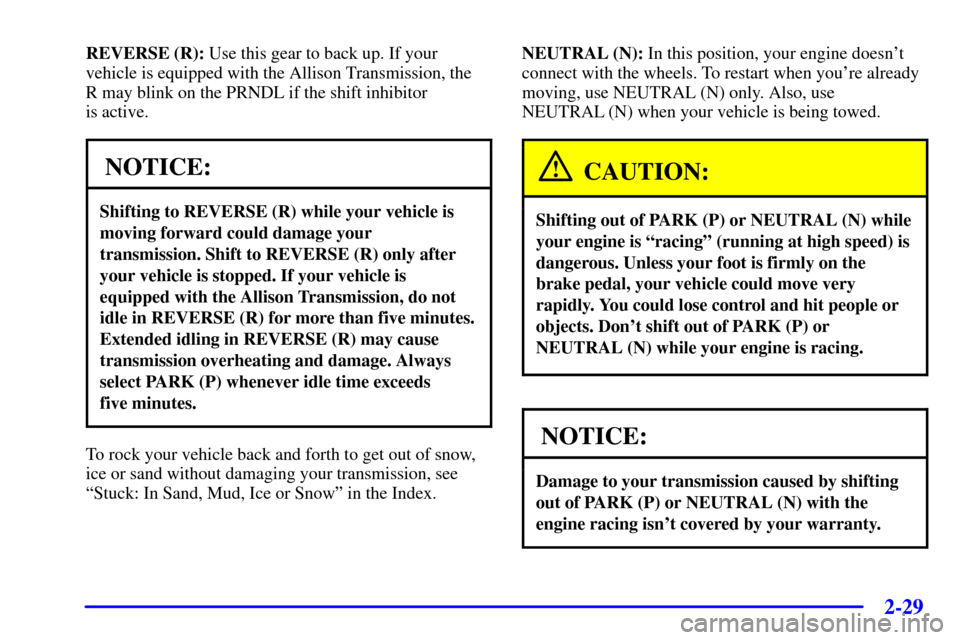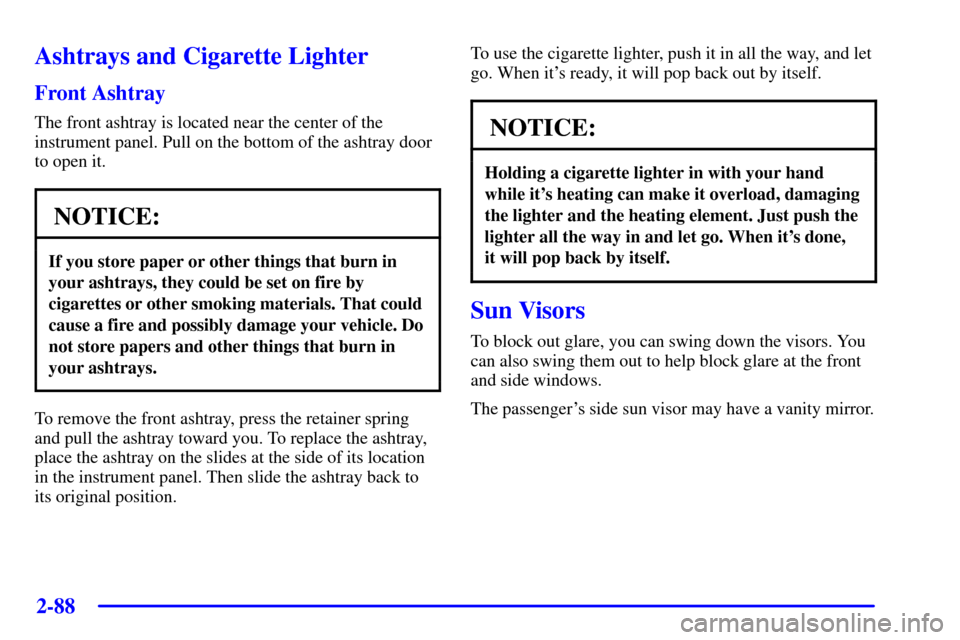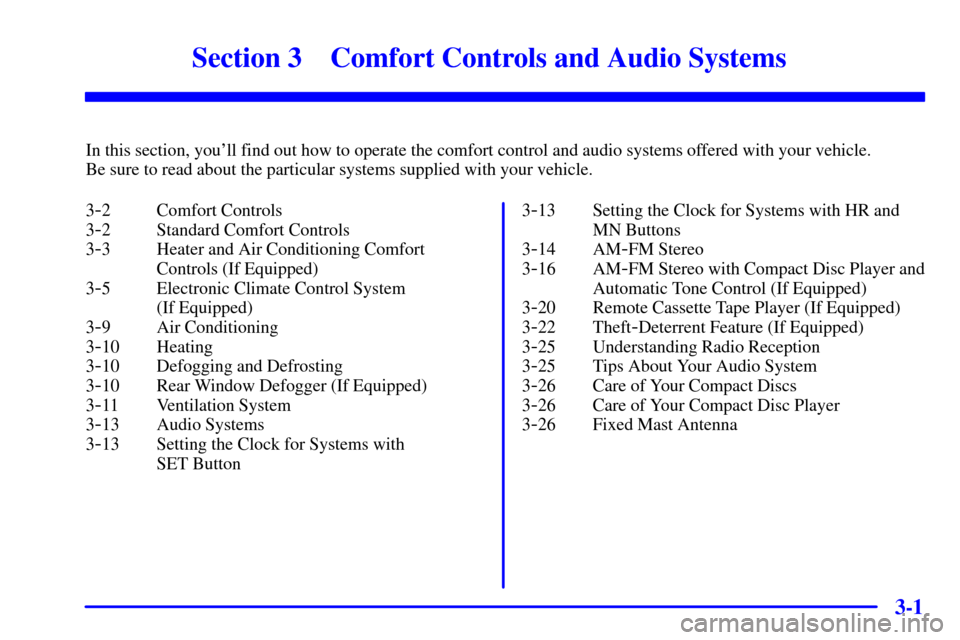Page 109 of 497

2-29
REVERSE (R): Use this gear to back up. If your
vehicle is equipped with the Allison Transmission, the
R may blink on the PRNDL if the shift inhibitor
is active.
NOTICE:
Shifting to REVERSE (R) while your vehicle is
moving forward could damage your
transmission. Shift to REVERSE (R) only after
your vehicle is stopped. If your vehicle is
equipped with the Allison Transmission, do not
idle in REVERSE (R) for more than five minutes.
Extended idling in REVERSE (R) may cause
transmission overheating and damage. Always
select PARK (P) whenever idle time exceeds
five minutes.
To rock your vehicle back and forth to get out of snow,
ice or sand without damaging your transmission, see
ªStuck: In Sand, Mud, Ice or Snowº in the Index.NEUTRAL (N): In this position, your engine doesn't
connect with the wheels. To restart when you're already
moving, use NEUTRAL (N) only. Also, use
NEUTRAL (N) when your vehicle is being towed.
CAUTION:
Shifting out of PARK (P) or NEUTRAL (N) while
your engine is ªracingº (running at high speed) is
dangerous. Unless your foot is firmly on the
brake pedal, your vehicle could move very
rapidly. You could lose control and hit people or
objects. Don't shift out of PARK (P) or
NEUTRAL (N) while your engine is racing.
NOTICE:
Damage to your transmission caused by shifting
out of PARK (P) or NEUTRAL (N) with the
engine racing isn't covered by your warranty.
Page 110 of 497

2-30
DRIVE (D): This position is for normal driving. If you
need more power for passing, and you're:
�Going less than about 35 mph (55 km/h), push your
accelerator pedal about halfway down.
�Going about 35 mph (55 km/h) or more, push the
accelerator all the way down.
You'll shift down to the next gear and have more power.
DRIVE (D) can be used when towing a trailer, carrying
a heavy load, driving on steep hills or for off
-road
driving. You may want to shift the transmission to
THIRD (3) or, if necessary, a lower gear selection if the
transmission shifts too often.
NOTICE:
If your vehicle is equipped with the Allison
Transmission, do not idle in DRIVE (D) for more
than five minutes. Extended idling in DRIVE (D)
may cause transmission overheating and damage.
Always select PARK (P) if idle time is longer than
five minutes.
If your vehicle is equipped with the Allison
Transmission, it will initially attain first range when
DRIVE (D) is selected. As vehicle speed increases, the
transmission will upshift automatically through each
available range up to FIFTH (5). As the vehicle slows,
the transmission will downshift automatically.
THIRD (3): This position is also used for normal
driving, however it offers more power and lower fuel
economy than DRIVE (D).
SECOND (2): This position gives you more power but
lower fuel economy. You can use SECOND (2) on hills.
It can help control your speed as you go down steep
mountain roads, but then you would also want to use
your brakes off and on.
If you manually select SECOND (2) in a light duty
automatic transmission, the transmission will drive in
second gear. You may use this feature for reducing the
speed of the rear wheels when you are trying to start
your vehicle from a stop on slippery road surfaces.
Page 168 of 497

2-88
Ashtrays and Cigarette Lighter
Front Ashtray
The front ashtray is located near the center of the
instrument panel. Pull on the bottom of the ashtray door
to open it.
NOTICE:
If you store paper or other things that burn in
your ashtrays, they could be set on fire by
cigarettes or other smoking materials. That could
cause a fire and possibly damage your vehicle. Do
not store papers and other things that burn in
your ashtrays.
To remove the front ashtray, press the retainer spring
and pull the ashtray toward you. To replace the ashtray,
place the ashtray on the slides at the side of its location
in the instrument panel. Then slide the ashtray back to
its original position.To use the cigarette lighter, push it in all the way, and let
go. When it's ready, it will pop back out by itself.
NOTICE:
Holding a cigarette lighter in with your hand
while it's heating can make it overload, damaging
the lighter and the heating element. Just push the
lighter all the way in and let go. When it's done,
it will pop back by itself.
Sun Visors
To block out glare, you can swing down the visors. You
can also swing them out to help block glare at the front
and side windows.
The passenger's side sun visor may have a vanity mirror.
Page 186 of 497
2-106
Engine Coolant Temperature Gage
United States Canada
This gage shows the engine coolant temperature.
It also provides an indicator of how hard your vehicle is
working. During a majority of the operation, the gage
will read 210�F (100�C) or less. If you are pulling a
load or going up hills, it is normal for the temperature to
fluctuate and approach the 250�F (122�C) mark. If the
gage reaches the 260�F (125�C) mark, it indicates that
the cooling system is working beyond its capacity.
See ªEngine Overheatingº in the Index.
Transmission Temperature Gage
(If Equipped)
United States Canada
Your vehicle may be equipped with a transmission
temperature gage.
When your ignition is on, the gage shows the temperature
of the transmission fluid. The normal operating range is
from 100�F (38�C) to about 265�F (130�C).
Page 198 of 497
2-118
Low Coolant
This message is displayed
when the cooling system is
low on coolant.
The engine may overheat. See ªEngine Coolantº in the
Index and have your vehicle serviced as soon as you can.
Check Coolant Temp
This message is displayed
when the cooling system
temperature gets hot.
Check the coolant temperature gage and the coolant
level. See ªEngine Coolantº and ªEngine Coolant
Temperature Gageº in the Index. See ªEngine
Overheatingº in the Index for further information.
Engine Overheated
This message is displayed
when the cooling system
temperature gets too hot.
This message will be displayed after the air conditioning
system has automatically turned off for the engine
coolant protection mode. See ªEngine Overheatingº in
the Index for further information.
Page 199 of 497

2-119
Reduced Engine Power
(V8 Gasoline Engines Only)
This message is displayed
when the cooling system
temperature gets too hot
and the engine further
enters the engine coolant
protection mode.
If your vehicle is equipped with the 8.1L engine, this
light may come on because of an electronic throttle
control system fault. See ªEngine Overheatingº in the
Index for further information.
Check Eng Oil Pressure
This message is displayed
when the engine oil pressure
is low.
See ªOil Pressure Gageº in the Index for
more information.
Check Eng Oil Level (Gasoline Engine)
This message is displayed
when the engine oil
level is low.
Once oil is added, it may need time to drain and settle in
the engine before this message will turn off. It is best to
let the engine cool down (if it is hot) or warm up (if it is
cold) and cycle the ignition to be sure this message turns
off. Refer to the dipstick for the correct level.
See ªEngine Oilº in the Index on how to check the oil
level and for what type of oil to add.
Page 203 of 497

3-
3-1
Section 3 Comfort Controls and Audio Systems
In this section, you'll find out how to operate the comfort control and audio systems offered with your vehicle.
Be sure to read about the particular systems supplied with your vehicle.
3
-2 Comfort Controls
3
-2 Standard Comfort Controls
3
-3 Heater and Air Conditioning Comfort
Controls (If Equipped)
3
-5 Electronic Climate Control System
(If Equipped)
3
-9 Air Conditioning
3
-10 Heating
3
-10 Defogging and Defrosting
3
-10 Rear Window Defogger (If Equipped)
3
-11 Ventilation System
3
-13 Audio Systems
3
-13 Setting the Clock for Systems with
SET Button3
-13 Setting the Clock for Systems with HR and
MN Buttons
3
-14 AM-FM Stereo
3
-16 AM-FM Stereo with Compact Disc Player and
Automatic Tone Control (If Equipped)
3
-20 Remote Cassette Tape Player (If Equipped)
3
-22 Theft-Deterrent Feature (If Equipped)
3
-25 Understanding Radio Reception
3
-25 Tips About Your Audio System
3
-26 Care of Your Compact Discs
3
-26 Care of Your Compact Disc Player
3
-26 Fixed Mast Antenna
Page 208 of 497

3-6
AUTO: If the knob is in AUTO, the fan speed will vary
as the system maintains the selected temperature.
When both the fan control and mode knobs are in the
AUTO position, the system will then automatically
maintain the last selected temperature setting. Manual
control of functions is also available.
Temperature Knob
The middle knob on the control panel lets you select the
desired air temperature in your vehicle. This knob will
allow you to adjust the interior air temperature setting.
Move the knob clockwise toward 82�F (28�C) for
warmer air. Move the knob counterclockwise toward
66�F (19�C) for cooler air. When the system is set for
automatic operation, sensors will control the fan speed.
Full Hot: If you turn the temperature knob past 82�F
(28�C), the system will go into the ªfull hotº mode.
The system will remain at that maximum heating setting
and the fan will blow at the speed the fan knob is set to.
If the fan is in AUTO, it will run at full speed.Full Cold: If you turn the temperature knob past 66�F
(19�C), the system will go into the ªfull coldº mode.
The system will remain at that maximum cooling setting
and the fan will blow at the speed the fan knob is set to.
If the fan is in AUTO, it will run at full speed.
Mode Knob
-- Manual Operation
The right knob on the control panel allows you to
choose the direction of air delivery.
You can choose to set the climate control system
yourself, or let the system work for you by placing the
system in AUTO mode. See ªMode Knob
-- Automatic
Operationº later in this section.
(Vent): This setting directs most of the air through
the instrument panel outlets and a small amount through
the floor outlets.
(Bi-Level): Air is delivered through the floor
outlets as well as the instrument panel outlets.
(Floor): This setting directs most of the air
through the floor outlets and some air through the
windshield defroster outlets.